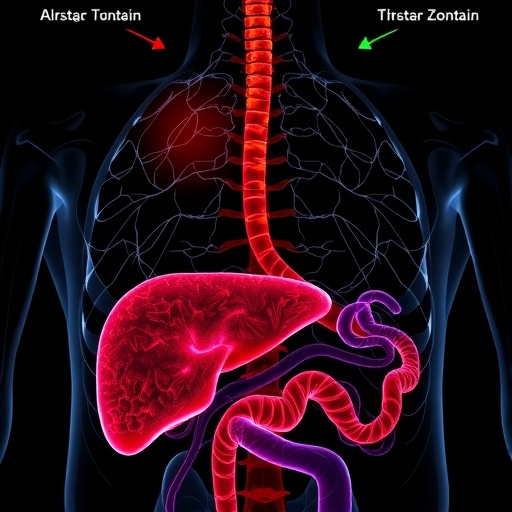In a groundbreaking study reshaping our understanding of liver biology and carcinogenesis, researchers have unveiled how the spatial distribution of hepatocytes within the hepatic lobule critically influences their susceptibility to oncogenic WNT signaling. This pivotal discovery highlights a nuanced picture: not all liver cells are created equal in their tumorigenic potential, even when exposed to identical oncogenic triggers.
At the heart of the liver’s complex architecture lies the hepatic lobule, organized into distinct zones, each characterized by unique metabolic and molecular profiles. The study concentrated on a specialized hepatocyte subpopulation expressing glutamine synthetase (GLUL), confined to a narrow, perivenous layer within zone 3. Astonishingly, despite the well-documented proliferative power of WNT signaling pathways in liver tumorigenesis, these GLUL-positive hepatocytes demonstrated a marked resistance to WNT-driven proliferation, challenging prevailing assumptions about oncogenic vulnerability.
To probe this phenomenon, the research utilized sophisticated genetically engineered murine models designed for precise spatial control of gene activation via Cre-lox recombination systems. By employing various zonally restricted Cre drivers, the scientists engineered targeted expression of oncogenes, notably mutant β-catenin (Ctnnb1^ex3/WT) and the MYC oncogene (R26^LSL-MYC), to dissect proliferation patterns across hepatic zones. This methodological rigor enabled an unprecedented fine-mapping of oncogenic responses along the lobular axis.
Their results revealed a striking gradient of proliferation: while MYC induction triggered broad hepatocyte proliferation throughout the liver lobule without zonal restriction, activation of mutant β-catenin selectively enhanced proliferation only in hepatocytes located immediately adjacent to, but distinctly outside, the GLUL-positive core sublayer. This proliferation was spatially correlated with a rise in insulin-like growth factor binding protein 2 (Igfbp2) expression, hinting at complex paracrine signaling mechanisms that might mediate microenvironmental susceptibility.
Further validating these findings, longitudinal analysis demonstrated the absence of delayed oncogenic growth within the GLUL^+ Lgr5^+ hepatocyte niche, even 20 days post induction. Histological assessments showed no evidence of hepatomegaly, abnormal proliferation, or mutant clone expansion in the central vein vicinity where these resistant hepatocytes reside. This temporal control ruled out the possibility that resistance was merely a delay rather than outright inviability to WNT-driven transformation.
Collectively, these insights underscore the profound influence of hepatic zonation on liver cancer initiation, offering a paradigm shift in how researchers must consider cell-of-origin effects in tumor biology. The protective niche of GLUL-positive hepatocytes raises critical questions about molecular and microenvironmental factors conferring resiliency to oncogenic insults, opening avenues for therapeutic exploitation.
Intriguingly, the study also elucidates how even a uniform oncogenic stimulus can elicit heterogeneous cellular responses depending on spatial context within an organ. The pervasive assumption that oncogene activation uniformly drives proliferation is thus nuanced by the revelation that intrinsic cellular fate and zonal positioning govern responsiveness.
This research bridges molecular genetics and spatial biology, harnessing single-cell analytics and advanced imaging to meticulously chart proliferative landscapes. The convergence of β-catenin and MYC oncogenic pathways offered comparative perspectives on the differential proliferative dynamics shaped by zonation. While MYC’s ubiquitous action confirmed its broad oncogenic potency, β-catenin’s restricted efficacy underscored the critical role of microenvironmental modulation.
From a clinical vantage point, these findings may inform liver cancer diagnostics and prognostics by identifying resistant cellular reservoirs unlikely to contribute to tumor progression, thereby refining strategies for targeted interventions. Understanding why GLUL-positive hepatocytes resist neoplastic transformation could unlock protective pathways exploitable in chemoprevention.
Moreover, the spatially restricted oncogenic resistance model adds a compelling layer to the dialogue surrounding liver regeneration and repair, highlighting how zonal commitment shapes not only normal physiology but also the landscape of pathological outcomes. These insights may have parallels in other solid organs exhibiting similar zonal heterogeneity.
Future research inspired by this work will need to dissect the signalling crosstalk and epigenetic programs intrinsic to GLUL^+ hepatocytes that underpin their unique fate. Elucidating the molecular circuitry and niche signals that enforce resistance could revolutionize understanding of tumor suppressive microenvironments.
Beyond the liver, this investigation sets a precedent for integrating spatial gene activation with cellular phenotyping to unmask context-dependent oncogenic vulnerabilities. It challenges cancer biologists to consider how tissue organization and cell fate decisively orchestrate tumorigenic potential.
This landmark study from Raven and colleagues heralds a new era in tissue-based cancer biology, leveraging spatial resolution to redefine oncogenic susceptibilities and chart novel paths for therapeutic innovation against hepatic malignancies.
Subject of Research: Hepatic zonation and its effect on tumorigenic potential of mutant β-catenin in the liver.
Article Title: Hepatic zonation determines tumorigenic potential of mutant β-catenin.
Article References:
Raven, A., Gilroy, K., Jin, H. et al. Hepatic zonation determines tumorigenic potential of mutant β-catenin. Nature (2025). https://doi.org/10.1038/s41586-025-09733-1
Image Credits: AI Generated
DOI: https://doi.org/10.1038/s41586-025-09733-1





